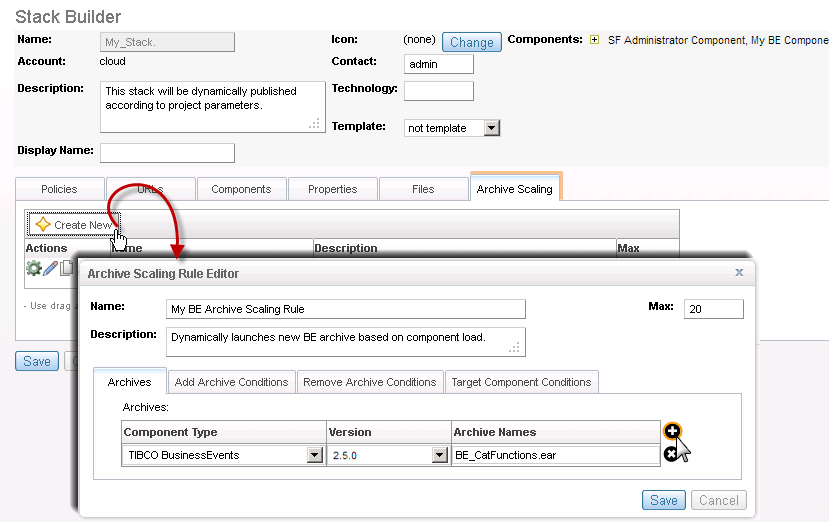Creating Archive Scaling Rules
You can define stacks that add or remove application archives based on archive statistics that are monitored for triggering conditions. Create Archive Scaling Rules to automate creation or removal of new BusinessEvents application archives when rules based on archive statistics meet or exceed thresholds or conditions you have set.
Procedure
- After adding components to your stack, you can create new scaling rules by opening the Archive Scaling tab and clicking the Create New button.
- Name your new archive scaling rule and give it a description to help you and others quickly identify the purpose and content of your archive scaling rule.
- The Archives tab defines what archive is added or removed according to the rules you define in the other tabs.
- Use the Add icon at the right of the column heading row to add one or more archives (process instances) to be scaled up or down in your stack.
- Select the BusinessEvents component that was used to upload the application archive file. Use the Archive Names field to specify which archive is subject to the rules you set using the other tabs of the Archive Scaling Rule Editor.
- Use the Add Archive Conditions tab and click the Add icon to the right of the column heading row to create and define a new Add Archive rule.
-
Select the statistics, the operator, the value, and the sampling window period (in seconds) to define your condition for adding a new archive.
Note: The sampling window must be a sufficiently large time period (in seconds) so that the aggregated statistics is collected. If the sampling window is not big enough statistics might not be reported in a particular time-frame creating an inadvertent trigger condition.
By default allocation statistics such as "Expected Engine Count", "Client Count", "Allocating Engine Count", and "Actual Engine Count" are collected every 60 seconds and by default, component statistics are collected every 10 seconds.
-
You can define more than one rule. With more than one rule, set the
Satisfies field to specify whether all rules must be satisfied or whether any one rule can be satisfied to trigger the addition of a new archive instance.
Optionally, you can set a preference for running new archives or new process instances on component instances with favorable usage profiles. Select the statistic that is most relevant to your implementation and you can create new process instances there according to those conditions you defined.
- Using the Remove Archive Conditions tab you can release computing resources and remove unused or idle component archives or process instances to scale down your component archives just as you scaled them up according to conditions you define on usage statistics.
-
Using the
Target Component Conditions tab you can restrict the start of new archive instances to those machines that have the same set of resources that you choose. Set a rule or several rules with statistics, operators, and values as you set on the Add archive conditions tab. Further restrict where the new archive instances might start depending on component instances that have:
- Same Component
- This setting works all the time for component archive scaling.
- From the set of Components
- This setting works only if your component archive is compatible with the set of components present. For example, a BusinessEvents archive does not scale on an adapter component.
- Same Component Type
- The process archive has the possibility of being scaled up on different versions of the product.
- Same Enabler
- Components that require a specific enabler should use this option.
- Same Middleware Version
- This selection ensures that a component archive that is created with a dependency on a specific compatible component runs on machines with that appropriate version of the middle ware: TIBCO TRA, TIBCO Hawk, etc.
- Same Enabler and Middleware Version
- This selection ensures that your component Archive scale up successfully, but it is the least restrictive of the target component conditions.
Tip: Only the selections: From the Same Set of Components or Same Enabler and Same Middleware Version works every time.
Provided that the component archive has the proper component type, TIBCO Silver Fabric can usually find the correct computing environment for scaling up. For example, for a BusinessEvents component archive, a selection of the "Same Component Type" ensures that the Silver Fabric Broker tries and finds an engine with same BusinessEvents component type on which to run the new BusinessEvents component archive.
Note: If the application that is to be scaled includes an HTTP Port Variable, you must set the HTTP Port Variable at the service level using TIBCO BusinessEvents® Studio. To make the HTTP Port Variable "service settable" select the Service Settable check box in the Global Variable Editor.Refer to the section "Working with Global Variables" in the TIBCO BusinessEvents Developers Guide for more information.


